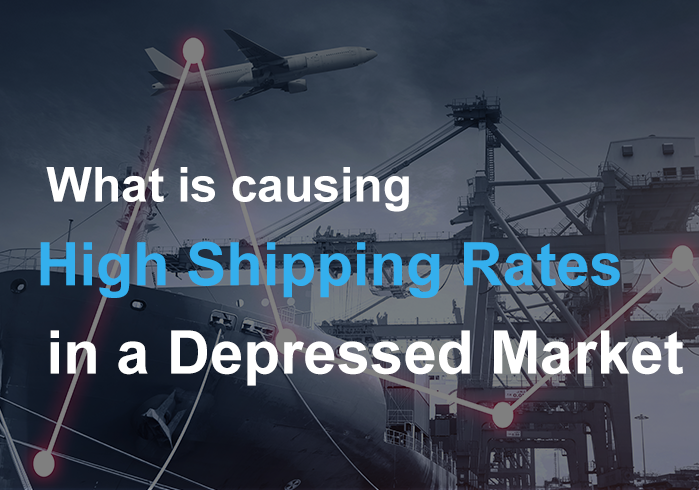
As Maersk released its quarterly performance statistics, many were left wondering about the high rates in a depressed market. This article provides a possible explanation. In purely global terms, demand for shipped merchandise has not yet boomed following the Covid-19 pandemic. Yet, shipping rates are high and still rising.
The answer to this puzzle is the fact that demand patterns in high activity areas such as the US are different from the global average. The rise in demand for online shopping in the US can more than compensate for the reduction in demand due to the pandemic. Besides, the industry is dealing with operational challenges such as a spike in congestion.
There have been high profile cases of ships being either delayed or completely stuck. One of the most notorious of these incidents happened in the Suez Canal, causing significant chaos within the sector. The demand in the US is driven by an injection of stimulus funds and accumulated savings. Moreover, there is now a preference for online shopping which inevitably involves shipping.
Rising global container shipping demand
As e-commerce takes hold, there has been an increased requirement for container shipping space. This demand has inspired the market into high freight rates. Spot rates are also rising because of operational decisions and an outlook that is not yet clear for the shipping industry.
According to the Maersk report, the second quarter of this year indicated an incremental global container demand of 2.7% when compared to the second quarter of the previous year. Interestingly, that was a time when the Covid-19 pandemic had not yet reached its zenith in terms of changing the shipping industry.
The demand statistics become more interesting when compared to the rise in freight rates (including spot and contract). Maersk revealed an average increment of 63% from the second quarter of the previous year to this year’s second quarter. The forty-foot equivalent unit was charged $1,868 per FEU previously in 2019 but is now charged $3,038.
Other data supports these patterns. For example, the Drewry World Container Index showed that the current spot rate of $9,371 per FEU is nearly seven times what it was in 2019. Lars Jensen of Vespucci Maritime suggested to American Shipper that global demand for the beginning of 2021 is 4% higher than it was two years ago. At that time, there were no significant capacity problems from a global perspective.
Such a relatively manageable demand rise should not be causing the kinds of issues we are seeing. In the absence of any other plausible explanations, experts have implicated a renewed demand boom in North America. Interestingly, this boom has not been fully reflected in other parts of the world, so it is skewed. Others suggest that the main problem is capacity within the shipping industry that has not caught up with market realities.
Impact of congestion on effective capacity
These operational challenges are made worse by congestion which curbs effective capacity. Delays are typically occurring in both transit and at ports, hence the knock-on effects of significant time-lags before the merchandise can reach the end customer. COVID-19 has challenged operational capacities in terms of staffing. However, the fleet growth that was meant to deal with these problems cannot compensate for dead, sick, or absent staff.
Many providers are reporting equipment that is fully tied up for the foreseeable future. For example, Maersk issued a customer advisory with the eye-catching headline: “Critical help needed — congestion increasing.” It was a call to action so that customers could increase the speed at which they returned equipment after use. Their forecasts anticipate demand rising through this year and next year.
Alphaliner reports increased demand for tonnage in Asia and the USA. Many ships are getting stuck and suffering long waiting periods. There are suggestions that an increment of up to 25% in fleet capacity may be required for Trans-Pacific routes. Big names such as Maersk are already confirming that effective fleet capacity has declined when compared to pre-pandemic statistics.
Vincent Clerc of Maersk reported that their fleet had grown by 2% from 2019, yet volumes were down by 3%. The implication is that it takes more twenty-foot units of fleet capacity (TEUs) to transport each forty-foot boxload of cargo (FFE). Only the reduction in congestion can rectify this problem. Experts have been intrigued as to how this situation came about in the first place.
The evolution of rate spikes in shipping
Demand pressures have been blamed on changing consumption patterns in the US, ecommerce becoming a popular option. The delays and shortages of capacity have added their own domino effect. Some companies are dealing with operational mishaps. Overall, there is weak investment in ship building when compared to demand.
The boom in the US has caught the shipping industry off-guard. Some have responded by shifting vessels and containers to different trades to leverage their flexibility. However, ports are static and delays there must be absorbed as an operational hazard. There are empty rail and track spaces, but not where they need to be in the USA.
Events such as the Suez Canal blockage and the closure of Yantian in China have not helped this situation. Even more worrying are rumors that the Delta variant of the Coronavirus is wreaking havoc in China, which only raises the prospect of more staff shortages. Virtually everything that could possibly go wrong has gone wrong. Nevertheless, there is optimism that the industry will recover from this.
These issues are only temporary
COVID-19 is slowly but surely being managed across the globe which raises the hope of a new normal that is tolerable to the shipping industry. The resilience of the industry means that it can weather the storm for now. It is anticipated that by 2022, congestion will be significantly reduced and that this will rebalance spot rates.
The extreme movements on short term rates mean that there is a chance the self-correction could be faster and more comprehensive than many anticipated. Underpinning this is a vaccination program that reduces deaths from COVID-19. The fundamentals of the industry must be worked on including improved capacity management through carrier consolidation. It is unlikely that the old market will be replicated. The impact of COVID-19 has simply been too great to completely reverse.
Wrapping up
Northern American demand for e-Commerce (and by extension shipping services) is causing spot rates to rise. This is despite the overall tapering of demand across the globe. Due to operational inefficiencies and mishaps, the industry finds itself facing a domino-effect of delays and costs. Because the COVID-19 pandemic is being slowly managed, some experts predict that these problems will only be temporary.



